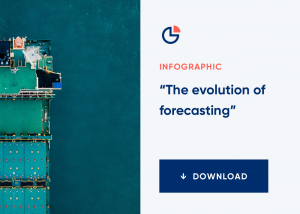Gartner’s Five Stages of Supply Chain Planning Technology Maturity
In any business or trade you need the right tools for the job, and supply chain planning is no different – you need the right technology for the job at hand. At every level of supply chain expertise and competitive differentiation you use certain tools, and seek others to move to the next level. In the 2017 Supply Chain Management Executive Conference presentation Exploring the Major Changes in Supply Chain Planning Technology through the Five Stages of Maturity, Gartner analyst Tim Payne described a representative tool for each level of supply chain maturity.
Tim says that Stage 1 maturity is typified by Excel spreadsheets. He calls this the Scotch tape of supply chain planning. Planning is departmentally focused, with lots of independent decisions. Companies selecting technologies at this stage are narrowly absorbed: They need something to provide a schedule at the departmental level. The deployments tend to be small and confined.
Payne compares Stage 2 tools to a hammer. Why? In stage 2 companies move from departmental to a process focus. They want to standardize and achieve consistency around demand planning by implementing best practices and using demand histories for better forecasting. The tool for this job, he says, is typically commercially available demand planning software. It’s a good tool, but an instrument good for mostly just one function. (Have you heard the expression, “When you have a hammer, everything looks like a nail.”)
Gartner calls Stage 3 maturity the Swiss Army Knife of supply chain planning. Companies want more integration; such as their demand plans to feed their inventory replenishment and production decisions. The focus here is on the breadth of application functionality and connecting things better. Companies want to move from stand-alone tools that create conflicts and disconnects to visibility across the corporation and a single version of the truth. This is when companies typically choose a planning System of Record (SOR) that will enable them to collaborate, simulate scenarios, and perform end-to-end planning.Gartner says Stage 3, regardless of how many improvements you make, can be deceptive. “This is a milestone on your journey, not a destination,” says Payne. “Stage 3 is not competitive advantage—it is table stakes.”
Stage 4 maturity is sort of a combination of the Swiss Army Knife plus automation equipment, Payne says. The automation represents Systems of Differentiation (SODs) that help respond to volatility, complexity, and ambiguity. Here, companies want more responsiveness and agility. They want higher-fidelity plans. They want processes like demand planning, inventory replenishment, S&OP and order promising to work well together.
A salient feature of the stage 3 to stage 4 transition is the need for technology that helps make better trade-offs and complicated decisions. Payne says that this role is often fulfilled by multi-echelon inventory optimization (MEIO) software. “Companies want to look across their end-to-end supply chain and figure out the best place to put inventory,” Payne says. “Do I put it into raw materials? Do I put in WIP? Do I have it in finished goods, and if so, which level of finished goods, to best address service level and demand variability?”Payne uses a robot to represent Stage 5. The technology most often found here he says is algorithmic planning. This stage is all about supply chain resilience—achieved through speed, scale, algorithms and automation. Companies may move into digital business models and broader supply chains; often with tons of data flowing through the system, sometimes from elements like the Internet of Things.Organizations cannot handle this stage with more people—they need better productivity from their planners, and they need those planners to be exercising their business acumen to add more value. Payne uses the analogy of the human brain. The conscious mind can handle about 4 stimuli per second; the subconscious is monitoring and responding to some 20 million events or stimuli per second. The lower stages of supply chain planning maturity are about conscious planning. As you move up into the higher maturity stages, you need the subconscious—algorithmic planning from end-to-end, connected to trading partners, suppliers, and customers, to optimize the supply chain and make it more agile in your markets.
Gartner sees companies evolving through maturity stages, progressing from local improvements to automated supply chain planning where they can quickly reconfigure the supply chain to adapt to change. Systems of Record, Systems of Differentiation, and Systems of Innovation characterize the advanced stages as they climb the ladder of expertise.
| Supply Chain maturity stage …. | typified by these technologies … | that are like …. |
| 1 | Spreadsheets | Scotch tape |
| 2 | Demand Planning | a hammer |
| 3 | Planning SORs | a Swiss Army Knife |
| 4 | MEIO & SODs | automation equipment |
| 5 | Algorithmic Planning | a robot |
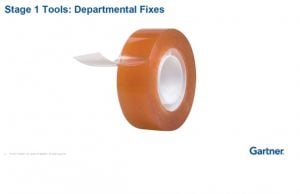 Tim says that Stage 1 maturity is typified by Excel spreadsheets. He calls this the Scotch tape of supply chain planning. Planning is departmentally focused, with lots of independent decisions. Companies
Tim says that Stage 1 maturity is typified by Excel spreadsheets. He calls this the Scotch tape of supply chain planning. Planning is departmentally focused, with lots of independent decisions. Companies 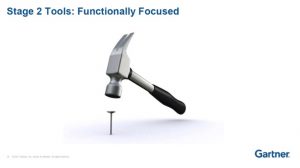 Payne compares Stage 2 tools to a hammer. Why? In stage 2 companies move from departmental to a process focus. They want to standardize and achieve consistency around demand planning by implementing best practices and using demand histories for better forecasting. The tool for this job, he says, is typically commercially available
Payne compares Stage 2 tools to a hammer. Why? In stage 2 companies move from departmental to a process focus. They want to standardize and achieve consistency around demand planning by implementing best practices and using demand histories for better forecasting. The tool for this job, he says, is typically commercially available 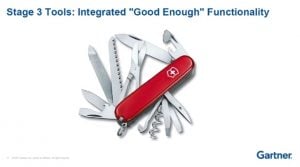 Gartner calls Stage 3 maturity the Swiss Army Knife of supply chain planning. Companies want more integration; such as their demand plans to feed their inventory replenishment and production decisions. The focus here is on the breadth of application functionality and connecting things better. Companies want to move from stand-alone tools that create conflicts and disconnects to visibility across the corporation and
Gartner calls Stage 3 maturity the Swiss Army Knife of supply chain planning. Companies want more integration; such as their demand plans to feed their inventory replenishment and production decisions. The focus here is on the breadth of application functionality and connecting things better. Companies want to move from stand-alone tools that create conflicts and disconnects to visibility across the corporation and 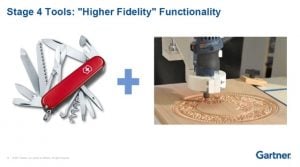 Stage 4 maturity is sort of a combination of the Swiss Army Knife plus automation equipment, Payne says. The automation represents Systems of Differentiation (SODs) that help respond to volatility, complexity, and ambiguity. Here, companies want more responsiveness and agility. They want higher-fidelity plans. They want processes like demand planning, inventory replenishment, S&OP and order promising to work well together.
Stage 4 maturity is sort of a combination of the Swiss Army Knife plus automation equipment, Payne says. The automation represents Systems of Differentiation (SODs) that help respond to volatility, complexity, and ambiguity. Here, companies want more responsiveness and agility. They want higher-fidelity plans. They want processes like demand planning, inventory replenishment, S&OP and order promising to work well together.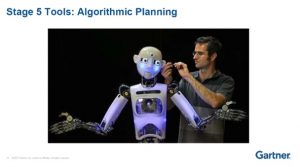 Payne uses a robot to represent Stage 5. The technology most often found here he says is
Payne uses a robot to represent Stage 5. The technology most often found here he says is 